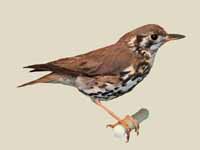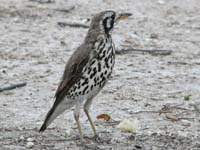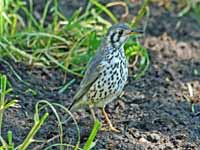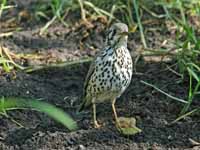BIRDS of THE WORLD - An Online Bird Book
TURDIDAE
Order Passeriformes Family Turdidae
Nightingale-Thrushes
TURDIDAE
Order Passeriformes Family Turdidae
Thrushes are plump, soft-plumaged, small to medium-sized birds, inhabiting wooded areas, and often feed on the ground or eat small fruit. Most species are gray or brown in color, often with speckled underparts. Even if the adults do not have these speckles, the juveniles often will. They are insectivorous, but most species also eat worms, snails, and fruit. Thrushes build cup-shaped nests, sometimes lining them with mud. They lay two to five speckled eggs, sometimes laying two or more clutches per year. Both parents help in raising the young. The songs of some species are considered to be among the most beautiful in the avian world.
The thrushes are presented on the following web pages:
1) Geokichla and Zoothera 2) Bluebirds 3) Solitaires
4) Nigthingale-Thrushes 5) True thrushes (Turdus) 6) Miscellaneous
The thrushes are presented on the following web pages:
1) Geokichla and Zoothera 2) Bluebirds 3) Solitaires
4) Nigthingale-Thrushes 5) True thrushes (Turdus) 6) Miscellaneous
Nightingale-Thrushes
The Nightingale-thrushes are mostly insectivorous or omnivorous thrushes of The Americas. Their eyes seem large compared with the rest of their small body.Their closest relative is the Wood Thrush.
Genus Catharus
Thrush,_Bicknell's Catharus bicknelli Found: North America (eastern)
Bicknell's Thrush has olive-brown upperparts; grayish-brown breast with spots; white belly with gray on the flanks; pink legs; faint gray eye-ring; gray cheeks.
Similar to: Gray-cheeked Thrush. Bicknell's Thrush only appears in the eastern part of North America while the Gray-cheeked thrush is much more wide spread.
Image by: 1, 2) Kent McFarland - Vermont 3) US Forest Service 4) KP McFarlandSimilar to: Gray-cheeked Thrush. Bicknell's Thrush only appears in the eastern part of North America while the Gray-cheeked thrush is much more wide spread.
1) Chicks 2) Juvenile 3) Adult
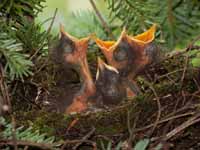
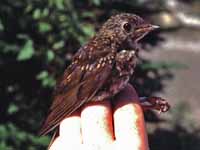
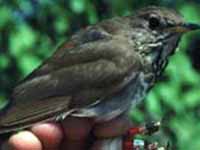
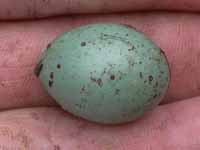
Thrush,_Black-billed_Nightingale- Catharus gracilirostris Found: highlands of Costa Rica and western Panama
The Black-billed Nightinggale-Thrush has olive-brown upperparts; gray crown, underparts; olive breast-band; black bill.
Image by:1) Jerry Oldenettel - Mirador de Quetzals, Costa Rica 2) Greg Gilbert - Costa Rica 3) Nick Athanas - Costa Rica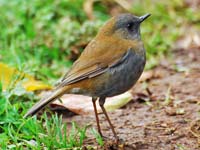
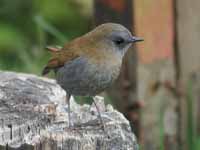
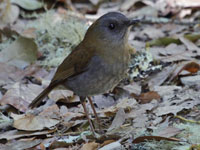
Thrush,_Black-headed Nightingale- Catharus mexicanus Found: Mexico, Central America
The Black-headed Nightinggale-Thrush has grayish-brown upperparts; black crown; bright orange eye-ring, bill, legs.
Image by: Michael Woodruff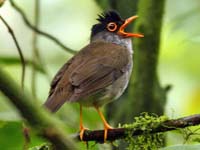
Thrush,_Gray-cheeked Catharus minimus Found: The Americas, Europe (rare, Asia (Siberia)
The Gray-cheeked Thrush has olive-brown upperparts; grayish-brown breast with darker spots; white belly; gray flanks; pink legs; faint gray eye-ring.
Similar to: Bicknell's Thrush. Bicknell's Thrush only appears in the eastern part of North America while the Gray-cheeked thrush is much more wide spread.
Similar to: Hermit Thrush. The Hermit Thrush has a reddish tail, the Gray-cheecked Thrush does not.
Image by: 1) Laura Gooch - Ohio 2) Kelly Azar - Pennsylvania 3) Jerry Oldenettel - New Mexico 4) badjobySimilar to: Bicknell's Thrush. Bicknell's Thrush only appears in the eastern part of North America while the Gray-cheeked thrush is much more wide spread.
Similar to: Hermit Thrush. The Hermit Thrush has a reddish tail, the Gray-cheecked Thrush does not.
3) This photo was taken in New Mexico and beyond Bicknell's Thrush range.
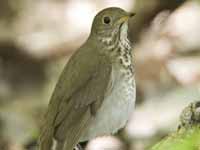
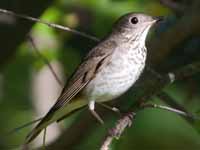

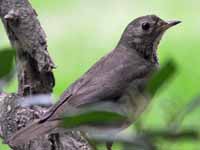
Thrush,_Hermit Catharus guttatus Found: North America
Similar to: Gray-cheeked Thrush. The Hermit Thrush has a reddish tail, the Gray-cheecked Thrush does not. Quoting The Sibley Guide to Books: The Hermit Thrush "is the only spotted thrush likely to be encountered in North America Nov. - March".
Image by: 1) Ed Gaillard - New York 2) Bill Bouton - California 3) Bhardwaj Shanthanu - Chicago, Illinois 4) Dick Daniels - California 5, 6) Dick - the North Carolina Zoo

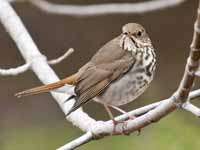
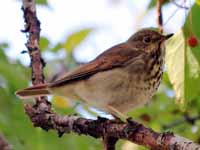
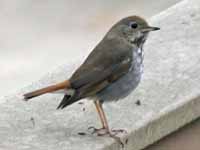
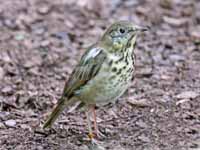
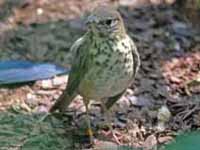
Thrush,_Orange-billed Nightingale Catharus aurantiirostris Found: Mexico, Central America, Venezuela
The Orange-billed Nightinggale-Thrush has brown back, crown; bright orange eye-ring, bill, legs; gray breast; whitish belly.
Image by: 1) Nigel_Voaden 2) Francesco Veronesi - Panama 3) Peter Grube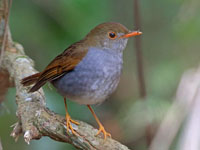
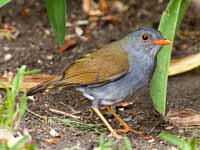

Thrush,_Ruddy-capped Nightingale- Catharus frantzii Found: Mexico, Central America
The Ruddy-capped Nightingale-Thrush has olive-brown upperparts; rufous crown, nape; pale gray underparts becoming whitish on the belly; orange lower mandible.
Image by: 1) Dominic Sherony 2) Amy McAndrews - Chiapas, Mexico 3) Muchaxo - Costa Rica 4) Nick Athanas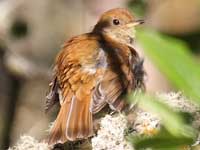
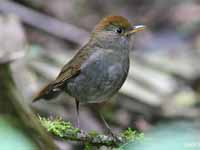
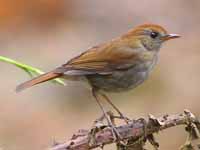
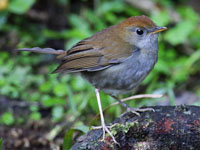
Thrush,_Russet Nightingale- Catharus occidentalis Found: Mexico
The Russet Nightingale-Thrush has brown upperparts; pale gray mottled underparts.
Image by: 1) Cornell_Univ's_Neotropical_Birds_Online - Andrew_Spencer 2) Dominic Sherony 3) Laurel Parshall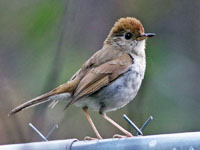
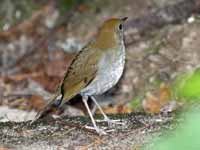
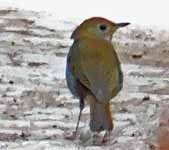
Thrush,_Slaty-backed_Nightingale- Catharus fuscater Found: Central America, northern South America
The Slaty-backed Nightingale-Thrush has mainly gray plumage; darker head, back; orange eye-ring, bill, legs.
Image by: 1) D Faulkner - Costa Rica 2) Nick Athanas - Columbia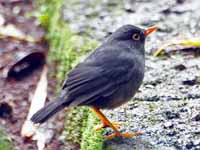
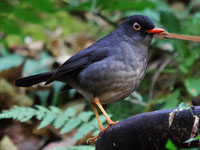
Thrush,_Spotted_Nightingale- Catharus dryas Found: Mexico, Central America, northern South America
The Spotted Nightingale-Thrush has olive upperparts; black head; red eye-ring;orange-red bills; yellow-tinged underparts with blackish spotting.
Image by: 1) Ana Agreda of the US Geological Survey 2) Nick Athanas - Ecuador 3) Amy McAndrews - Chiapas, Mexico 4) Jorge Montejo - Chiapas
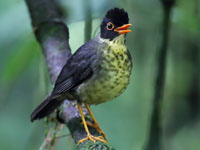
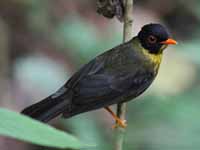
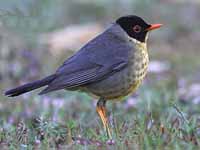
Thrush,_Swainson's also Olive-backed Thrush Catharus ustulatus Found: The Americas
The Swainson's Thrush has brown upperparts, flanks; light brown breast with darker spots; whitish belly; pink legs; pale eye-ring.
Similar to: Veery Thrush. The Veery has lighter spots and also fewer spots than does Swainson's Thrush. Swainson's Thrush has a more distinct eye-ring.
Image by: 1) Matt Reinbold - North Dakota 2) Gerry - British Columbia
3) Laura Gooch - Ohio 4) Ken Schnider - Florida 5) Dick Daniels - South CarolinaSimilar to: Veery Thrush. The Veery has lighter spots and also fewer spots than does Swainson's Thrush. Swainson's Thrush has a more distinct eye-ring.
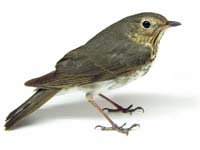
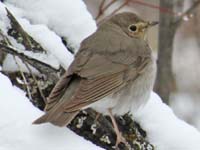
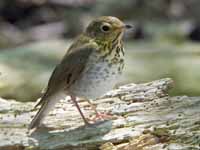
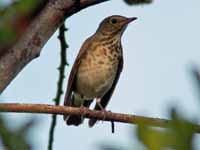
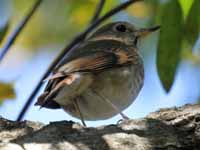
Veery Catharus fuscescens Found: The Americas
The Veery has light brown upperparts; tawny upper-breast with spots; white lower-breast, belly; pink legs.
Similar to: Swainson's Thrush. The Veery has lighter spots and also fewer spots than does Swainson's Thrush. Swainson's Thrush has a more distinct eye-ring.
Image by:1) National Park Service 2) Cephas - Quebec 3) Bill Lynch - New Jersey 4) Kelly Azar Similar to: Swainson's Thrush. The Veery has lighter spots and also fewer spots than does Swainson's Thrush. Swainson's Thrush has a more distinct eye-ring.
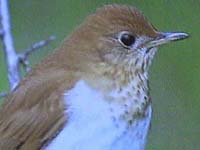
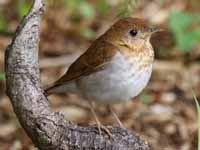
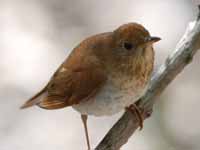
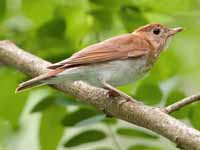
Genus Hylocichla - 1 species
Thrush,_Wood Hylocichla mustelina Found: North America
The Wood Thrush has brown upperparts; mottled brown and white underparts.
Similar to: Ovenbird. Ovenbird has stripes on breast; Wood Thrush has spots on breast.
Image by: 1) Steve Maslowski, USFWS 2) Charlie Westerinen near Tonopah, Nevada 3) Dendroica cerulea - New York 4) Sergey_Pisarevskiy - GuatemalaSimilar to: Ovenbird. Ovenbird has stripes on breast; Wood Thrush has spots on breast.
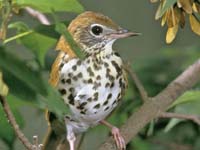
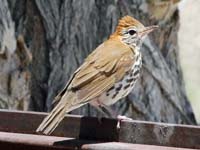

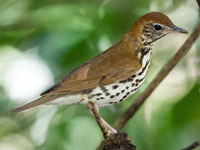
Genus Psophocichla - 1 species
Thrush,_Groundscraper Psophocichla litsitsirupa Found: Africa
The Groundscraper Thrush has gray-brown upperparts; white underparts with black spots; white face with bold black markings.
Image by: 1) Dick Daniels - specimen in Nairobi National Museum, Kenya 2) Alastair Rae 3, 4)
Sandy Cole - BIrds of Eden,
South Africa